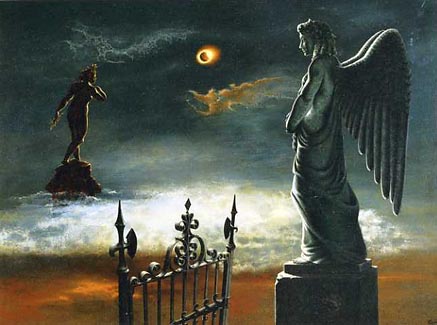for natural subjects. A number of recent paintings
are landscapes, some in the great tradition of the Hudson
River School. The many nightscapes are quite unusual. On closer
examination, the atmosphere in these works often seems
reminiscent of what has been referred to as Luminism. This
type of art encompassed landscapes produced by certain
American artists of the mid 19th Century, who developed
technical proficiency in portraying the exquisite qualities of
lighting and atmosphere. Most notably were Fitz Hugh Lane,
John Frederick Kensett, Frederic Edwin Church,
Albert Bierstadt and
Martin Johnson Heade. In the case of Rob Evansí
more intimate paintings, Headeís work is the most comparable,
as many of his works were close studies. When considering Rob
Evans' riverscapes and seascapes, works by Kensett also come
to mind.
Few artists have painted nightscapes. A notable example was
Caspar David Friedrich, the German Romanticist. His work
was grounded in nature, but he also strove to express a
metaphysical dimension in his paintings. The design of a
number
of Rob Evansí paintings seem reminiscent of Friedrichís
nocturnal works.
Another
artist brought to mind by Rob Evansí paintings is
George C.
Ault. Although he is generally grouped with the Precisionist,
Ault did not share in their admiration of the Modernist
aesthetic. His early works generally
explored architectural themes
inspired by New York City and surrounding
areas where he lived at the time. After moving to Woodstock,
New York, in 1937 he became reclusive. His
paintings from that time almost exclusively portrayed rural scenery,
alternating between rigorous and naÔve-like styles. In the
early 1940s he produced a number of somewhat mysterious nocturnal
studies based on Russellsí Corners, a nearby rural
intersection.. The
mood of these paintings is similar to the atmosphere felt in
many of Rob Evansí
works. At the same time, many of Rob Evansí early paintings are
rendered in a meticulously precise style, with
similarities to those works which George Ault painted in a
Precisionist manner.
generally
explored architectural themes
inspired by New York City and surrounding
areas where he lived at the time. After moving to Woodstock,
New York, in 1937 he became reclusive. His
paintings from that time almost exclusively portrayed rural scenery,
alternating between rigorous and naÔve-like styles. In the
early 1940s he produced a number of somewhat mysterious nocturnal
studies based on Russellsí Corners, a nearby rural
intersection.. The
mood of these paintings is similar to the atmosphere felt in
many of Rob Evansí
works. At the same time, many of Rob Evansí early paintings are
rendered in a meticulously precise style, with
similarities to those works which George Ault painted in a
Precisionist manner.
Recurrent
features in Rob Evansí paintings suggest his connection to the
American Magic Realists of the mid 20th Century. Magic Realism stemmed from the
Metaphysical art of Giorgio de
Chirico, who stated that his objective was "to find the
daemon in everything". Strong shadows in his early Piazza
díItalia paintings contributed to their dreamlike mood. Plumes
of white smoke billow from locomotives in many of these
paintings, a metaphor for his father, who was a railroad
engineer. Pillars of smoke can also be seen in the works of
Magic Realists, for example in works by
Carel Willink, Pierre Roy and
E.J. Hughes. In Rob Evansí paintings,
the columns of smoke evoke the mysterious and suggest an
enigmatic source. This is the realm of the uncanny, of the
phenomenal. It seems that they are likely the byproducts of
human activity, but as to exactly what kind we can only guess.
Magic Realism stemmed from the
Metaphysical art of Giorgio de
Chirico, who stated that his objective was "to find the
daemon in everything". Strong shadows in his early Piazza
díItalia paintings contributed to their dreamlike mood. Plumes
of white smoke billow from locomotives in many of these
paintings, a metaphor for his father, who was a railroad
engineer. Pillars of smoke can also be seen in the works of
Magic Realists, for example in works by
Carel Willink, Pierre Roy and
E.J. Hughes. In Rob Evansí paintings,
the columns of smoke evoke the mysterious and suggest an
enigmatic source. This is the realm of the uncanny, of the
phenomenal. It seems that they are likely the byproducts of
human activity, but as to exactly what kind we can only guess.
Rob Evans follows
in the footsteps of
a number of American Magic Realists. Andrew Wyeth was a master of concealment much of the content in
his paintings, leaving only
a few clues as to their real meaning. Most of his works
utilize a carefully selected number of elements, yet rendered
in exquisite detail. Alex Colville's approach was similar.
Although many works of
Magic Realism contain surreal nuances, the general approach
differs greatly from that of orthodox Surrealism, which
promoted spontaneity and the injection of the absurd. Through
understatement Magic Realism became a powerful vehicle for
creating metaphors and evoking memories. Thus Rob Evans'
Toy Horse may be the Trojan Horse, with Troy burning in
the background. Visit Rob's gallery and see what special
stories of your own you can find there.
Some additional Magic Realists to compare:
Charles Rain, John
Rogers Cox, John Wilde and
Franz Radziwill. For a more
complete discussion of the differences between Magic
Realism and Surrealism, visit the
American Magic Realism gallerry.